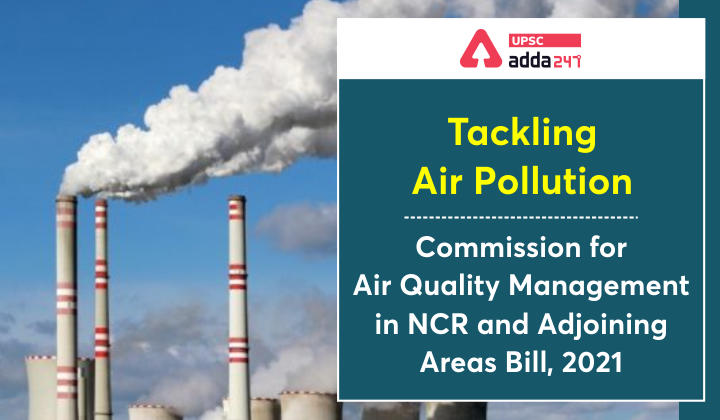Table of Contents
Relevance
- GS 3: Environmental pollution and degradation.
Context
- Commission for Air Quality Management in NCR and Adjoining Areas Bill, 2021 was recently introduced in Lok Sabha to tackle the increasing air pollution.
Key points
- The Bill seeks to replace the past ordinance.
- It seeks to constitute a Commission for better co-ordination, research, identification, and resolution of problems related to air quality in the National Capital Region (NCR) and adjoining areas.
- Adjoining areas have been defined as areas in the states of Haryana, Punjab, Rajasthan, and Uttar Pradesh adjoining the NCR where any source of pollution may cause adverse impact on air quality in the NCR.
- It decriminalises the act of stubble burning and withdraws the clause that mentioned the possible jail time.
 Get free video for UPSC CSE preparation and make your dream of becoming an IAS/IPS/IRS a reality
Get free video for UPSC CSE preparation and make your dream of becoming an IAS/IPS/IRS a reality
Commission for Air Quality Management
- It was first established though an Ordinance that was promulgated in October, 2021.
- It dissolves the Environment Pollution Prevention and Control Authority established in the NCR in 1998.
-
Functions
- It will plan and execute such plans to prevent and control air pollution in the NCR.
- It may impose and collect environment compensation—decided by the central government—from farmers causing pollution by stubble burning.
-
Powers
- It will be the sole authority with jurisdiction over matters defined in the Bill.
- It will issue directions on matters including inspections, or regulation which will be binding on the concerned person or authority.
- t will identify violators, monitor factories and industries and any other polluting unit in the region, and can also shut down such polluting units.
- In case of any conflict, the orders or directions of the Commission will prevail over the orders of the respective state governments, the Central Pollution Control Board (CPCB), state PCBs, and state-level statutory bodies.
-
Composition
It will consist of:
-
- a chairperson,
- an officer of the rank of a Joint Secretary as the member-secretary and Chief Coordinating Officer
- a currently serving or former Joint Secretary from the central government as a full-time member
- three independent technical members with expertise related to air pollution, and
- three members from non-government organisations.
It will also include ex-officio members:
-
- from the central government and concerned state governments, and
- technical members from CPCB (Central Pollution Control Board), Indian Space Research Organisation (ISRO), and NITI Aayog.
- A Selection Committee will be formed to recommend the appointments of the members. The Committee will be headed by the Minister of the Ministry of Environment, Forest and Climate Change.
Why needed?
- There is a lack of a permanent, dedicated and participative mechanism that could adopt a collaborative and participatory approach to tackle air pollution, in the NCR and adjoining areas.
- Also, sources of air pollution, particularly in the NCR, consist of a variety of factors which are beyond the local limits of the NCR.
- Special focus was required on all sources of air pollution which are associated with different economic sectors, including power, agriculture, transport, industry, residential and construction.
Way forward
- The institution should work closely work with all the stakeholders and must not follow a top-down approach to achieve the intended objectives.



 TSPSC Group 1 Question Paper 2024, Downl...
TSPSC Group 1 Question Paper 2024, Downl...
 TSPSC Group 1 Answer key 2024 Out, Downl...
TSPSC Group 1 Answer key 2024 Out, Downl...
 Cabinet Ministers of India 2024, New Cab...
Cabinet Ministers of India 2024, New Cab...







